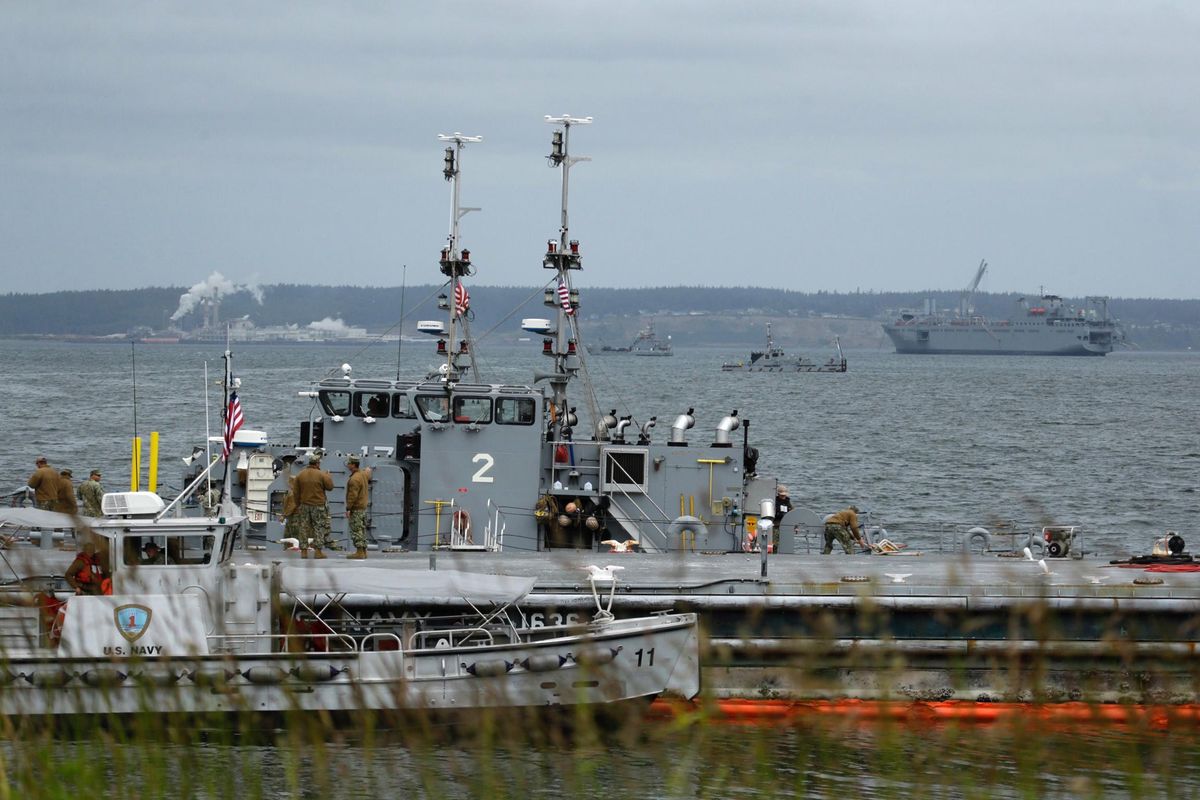Cascadia Rising: A massive response by sea for a catastrophic quake

NAVAL MAGAZINE INDIAN ISLAND, Wash. – The figures for projected loss in the first hour of a massive Cascadia Subduction Zone quake and tsunami are staggering.
Almost nearly as staggering, the kind of support the nation could muster in the ensuing weeks and months for rescue, resupply and rehabilitation.
As federal, state, tribal and local military and civilian emergency management teams began their second day of Cascadia Rising, a multistate drill to practice their responses to 9.0 earthquake and the tsunami it would generate, Lt. Col. Clay Braun of the Washington National Guard laid out the experts’ best estimates of the aftermath.
A federal study concluded there would be almost no working hospitals in Western Washington west of Interstate 5, and all senior living facilities would have to be evacuated for lack of power, water and sewer. That’s about 80,000 people who would need to be evacuated for medical care, not counting casualties from the quake and tsunami.
Thirty percent of fire stations would be unusable, most of them collapsed with the trucks and equipment in them; 41 percent of police stations would be destroyed. Many roads and half the bridges in Western Washington would sustain significant damage.
Power would be out along the Pacific Coast from British Columbia to San Diego, as far east as Montana and New Mexico. Power likely would come back on in Eastern Washington in the first week, in the Puget Sound in months, and on the Washington coast, possibly not for more than a year.
“You’ve been thrust back in time to the 1850s,” Braun, the deputy operations officer of Cascadia Rising, told visiting dignitaries. “You cannot get to the coast of Washington by ground.”
Within hours after the quake, the Defense Department would begin loading a huge cargo vessel like the U.S. Navy Ship Bob Hope, with food, water, fuel and equipment for the sailors and soldiers who would help deliver it. It would take about a week to fully load, and three to four days to reach the Northwest.
The Bob Hope, currently anchored off Indian Island between Port Townsend and Port Ludlow, can carry a half-million square feet of cargo, three “ferry” boats to bring them to shore where there is no pier or port facility and two utility “taxis” to bring about 50 sailors from the ship ashore. Others would arrive by air.
They would begin setting up a tent city for the military response, like members of the U.S. Transportation Command have been doing for more than two weeks on Indian Island. They have established a fully operational facility for 850 personnel. For their Joint Logistics Over the Shore exercise – JLOTS in military speak – they actually only have about 500 sailors, soldiers, Marines and Coast Guardsmen on-site. But they have fully functioning galleys with three meals a day, showers, power, vehicles and medical facilities.
The Army also has sent a team to set up an Inland Petroleum Distribution System, which could pipe fuel from a ship to polyurethene storage “bags” miles away that hold about 210,000 gallons each. When the system is set up, it could deliver 48,000 gallons of fuel an hour, round the clock if necessary.
The area on the island being used for practice isn’t big enough to hold the standard tanks, so they brought two small ones, which hold 50,000 gallons each.
Every year the Transportation Command does a JLOTS exercise somewhere, and for 2016 they linked up with Cascadia Rising. Capt. Greg Vinci, commander of the Naval Support Element set up on the island, said he was part of a team that deployed to Port Au Prince, Haiti, for two months right after the 2010 earthquake.
That country was devastated, and the port was destroyed so the only way to get military or civilian supplies in was through a system like the one they were practicing, he said. He wonders if the destruction to the Northwest would be worse because there are more people in the quake zone.
North of the island in Port Townsend, the Washington National Guard had set up one of its decontamination stations, practicing something that would be a daily ritual for any emergency worker in the quake zone.
The quake would break fuel lines and bring down houses, and the tsunami would wash over the landscape that also includes cars, septic systems, factories and animal carcasses, creating a toxic stew. Every worker coming off shift, and all vehicles they drive, would have to be scrubbed, Capt. Allen Hale of the 792nd Chemical Reconnaissance Unit, said. They’d be sprayed and scrubbed with water trucked in from some supply point, and a cleaning agent.
It’s main ingredient? “Basic dish soap,” Hale said.